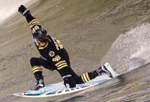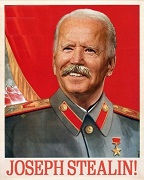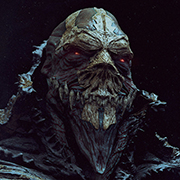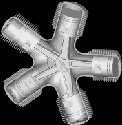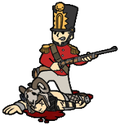Throatwarbler posted:It doesn't take into account the fact that American division had 18-20,000 men while a Chinese division had only 10,000, and the difference mostly lay in the attached tank and artillery battalions of the American division which was a powerful combined arms formation while the Chinese division was just a collection of rifle infantry. For every man you have fighting you have a corresponding increase of men required to support him, both inside and outside of the division. Cooks, mechanics, ammo handlers, trucker drivers, medical personnel, etc. Overall troop numbers are deceiving for Americans because xxx,xxx troops doesn't mean there was xxx,xxx guys available for front line service. You have to realize that not every American or even every American combat division in Korea crossed the 38th parallel and was advancing towards the Yalu, right?
|
|
|
|
|

|
| # ? Apr 19, 2024 23:03 |
|
asbo subject posted:Its not a colloquialism, or if it is, it is an English colloquialism. Any Englishman would understand it. English is the language of Englishmen. The burden of ensuring communication is understood lies with the one communicating the message, in this case the Englishman. Not to mention his duty to provide clear concise reports to his superior, which "a bit sticky" probably doesn't live up to. It'd be like if an American was in charge of the unit and reported to his superior that the situation was "forth and long" they'd have no idea what the gently caress he was talking about unless they watched American football.
|
|
|
|
A Dapper Walrus posted:Thanks for all of that. I was curious because of how history portrayed such fighters as 'dishonorable' or some other similar term. Portrayed? Iraqi insurgent and Talibans are still considered cowards and shameless for doing gangster tactics. Whenever a inferior force sees that their chances in open combat are null they will retreat to the hills, woods and mountains and use the knowledge of local terrain to inflict punishment by indirect means. The British hated it, the French hated it, the Germans hated it and the Americans hate it too. It has a lot to do with the smugness inherent to having a clear superior force in quality to the opposition but the enemy simply won't face you like gentlemen.
|
|
|
|
Mans posted:Portrayed? Iraqi insurgent and Talibans are still considered cowards and shameless for doing gangster tactics. Whenever a inferior force sees that their chances in open combat are null they will retreat to the hills, woods and mountains and use the knowledge of local terrain to inflict punishment by indirect means. The British hated it, the French hated it, the Germans hated it and the Americans hate it too. It has a lot to do with the smugness inherent to having a clear superior force in quality to the opposition but the enemy simply won't face you like gentlemen. I do love how pretty much killing your opponent from the air and sea before they can see you is gentlemanly.
|
|
|
|
DarkCrawler posted:I do love how pretty much killing your opponent from the air and sea before they can see you is gentlemanly. Even if there was no airforce or navy involved "gentlemanly" would still be the best tanks, attack helicopters, and army in the world vs third worlders.
|
|
|
|
Flippycunt posted:The burden of ensuring communication is understood lies with the one communicating the message, in this case the Englishman. It sounds more like a doctrinal gently caress up, like the Charge of the Light Brigade. If you want to have efficient communications between your forces, you must ensure that all parties have training that emphasizes the importance of unambiguous communications. Were the UN commanders thoroughly trained for this? If not, I wouldn't put the blame on any individual - it's the kind of thing that NATO was created for. Generals usually have a lot more to think of than how another English speaking person might conceive their message that their English speaking countrymen would understand loud and clear. Such fine points need to be hammered home to them. Nenonen fucked around with this message at 22:36 on Dec 28, 2011 |
|
|
|
Mans posted:It has a lot to do with the smugness inherent to having a clear superior force in quality to the opposition but the enemy simply won't face you like gentlemen. Mostly, though, I think it comes from the feeling of impotence when your beautiful by-the-book tactics don't work. It happens even in conventional warfare. In WW2 one German commander objected to the Allied use of self-propelled guns in direct fire role as being against Geneva convention. It's quite universal. Even guerrillas tend to complain of cowardice and unmanliness when the opponent uses tactics they weren't prepared for, like UAV's. And as conflicts move to the networks, these cries will be even louder. Just think how the victims of Anonymous feel. Now add some national pathos to it.
|
|
|
|
canuckanese posted:I'm not 100% sure but I'm pretty sure by 1066 most people in Europe knew about the stirrup. I think the English defeat was mostly due to the fact that the English didn't have any cavalry at all, plus the fact that they had just fought a battle three weeks earlier against the Vikings and had to march south pretty rapidly to face the Normans. The English were actually holding their own at first but when the Normans started to fall back they broke ranks from the shield-wall and tried to chase them down, allowing the Norman cavalry to counterattack and slaughter the disorganized English infantry with relative ease. Rabhadh posted:Stirrups by that point in time had been well spread and the Anglo-Saxons had them too. However, the main battlefield tactic of the Anglo-Saxons was the shieldwall, and Hastings was pretty much the perfect battlefield for a shieldwall. They were sitting on top of a ridge and had only to hold the field until the Normans either starved, disease spread through their camp or the political situation in Normandy changed enough to warrant William having to go back. Thanks! I had always thought Hastings was won primarily because Harold's army was exhausted and couldn't keep their act together, I thought the stirrup thing was BS when I heard it. Just wanted to check.
|
|
|
|
Mans posted:Portrayed? Iraqi insurgent and Talibans are still considered cowards and shameless for doing gangster tactics. By who? I spent a long time up to my neck in both of those messes and don't recall ever hearing the insurgents described as "cowardly" by anyone on our side. If anything they're thought of as the total opposite...they're fanatical, totally untroubled by the prospect of death, and kind of dumb sometimes, which is a recipe for some crazy acts of bravery. They routinely did things that we wouldn't have even thought of doing...while we generally stayed behind armored things as much as we possibly could. If anything we thought of ourselves as a lot less brave than they were; they didn't need SAPI plates or C-RAM or obnoxious air force guys who could make planes fry whatever you wanted. bewbies fucked around with this message at 23:55 on Dec 28, 2011 |
|
|
bewbies posted:By who? I spent a long time up to my neck in both of those messes and don't recall ever hearing the insurgents described as "cowardly" by anyone on our side. If anything they're thought of as the total opposite...they're fanatical, totally untroubled by the prospect of death, and kind of dumb sometimes, which is a recipe for some crazy acts of bravery. They routinely did things that we wouldn't have even thought of doing...while we generally stayed behind armored things as much as we possibly could. If anything we thought of ourselves as a lot less brave than they were; they didn't need SAPI plates or C-RAM or obnoxious air force guys who could make planes fry whatever you wanted. Well the use of IEDs, suicide bombs and murder-intimidation campaigns against civilians are generally regarded as cowardly. But, that's just the nature of the beast when conducting an insurgency. Like you pointed out, I don't think anyone would say the Afghan insurgents are cowardly in battle.
|
|
|
|
|
bewbies posted:SAPI plates or C-RAM Militaria Glossary Time, because not everyone wants to look this stuff up on Wikipedia. SAPI - Small Arms Protective Insert, basically some extra armor that goes into your armor so bullets are less likely to penetrate and bust a nut in your organs. C-RAM - Counter Rocket, Artillery, and Missile, think a Phalanx anti-missile system like you see on a ship packed into a truck. They're designed to blow up missiles and mortar shells before they impact and bust a nut in your mess tent.
|
|
|
|
quote:Well the use of IEDs, suicide bombs and murder-intimidation campaigns against civilians are generally regarded as cowardly Not to be contradictory, but is it really generally regarded as cowardly? I know that within military circles the opposite is true, its dam effective and while not valid by our standards, definitely not cowardly.
|
|
|
|
Eh, a lot of the people I've known since I've been in have echoed the thought that the people we're fighting in Afghanistan and Iraq are cowardly because of their justified tactics against us. I've had quite a few conversations where I've been told that they're pussies for fighting from the shadows or whatever. Even trying to reason with a lot of people like that doesn't work sometimes. I don't know, I guess they just need a reason to justify their superiority over the 'others'. Or something. Sorry, don't want to derail this thread, there's a lot of drat interesting information here. Just suffice it to say that the military of any nation attracts somewhat nationalistic people.
|
|
|
|
Red7 posted:Not to be contradictory, but is it really generally regarded as cowardly? I know that within military circles the opposite is true, its dam effective and while not valid by our standards, definitely not cowardly. If you asked the opinion of any civilian who lived in a bombed European city during WW2, they'd probably describe the act of bombing civilian targets as 'cowardly', among other, even less flattering terms. Not because anyone thinks that flying through enemy fighter and flak screens is cowardly but because the act of bombing civilians is. The same applies to unrestricted submarine warfare, people who suffer from it generally don't think highly of the people doing so. It's just not fair.
|
|
|
Red7 posted:Not to be contradictory, but is it really generally regarded as cowardly? I know that within military circles the opposite is true, its dam effective and while not valid by our standards, definitely not cowardly. In my experience and purely anecdotal, I've never heard of a single Marine applaud the bravery of a bombmaker or placer. I mean, no one is going to applaud the bravery of a man for sneaking out onto likely patrol routes and placing the bomb that killed or maimed a friend of theirs but wouldn't(for very obvious reasons) stand up in a fair fight. They might say that the IED is effective and often the only weapon available to the insurgents. They might also grudgingly applaud the ingenuity of the guy making or planting the bomb. They would almost certainly say something like what Bewbies posted. They would probably acknowledge, consciously or not, that the IED is often the only weapon available to insurgents. This is purely anecdotal but no one I know is saying they're brave for placing IEDs. The US opinion of IED maker's/planter's morals or bravery doesn't make IEDs any less effective. Effectiveness and cowardice are not mutually exclusive properties.
|
|
|
|
|
Do these people think that the insurgents and ISAF should meet on an open plain and choose champions for single combat or something? Logically you use what you can, if you have IEDs you use IEDs, if you have armored support and CAS you use your tanks and planes. I don't see how this warrants debate.
|
|
|
|
SO ANGRY posted:Eh, a lot of the people I've known since I've been in have echoed the thought that the people we're fighting in Afghanistan and Iraq are cowardly because of their justified tactics against us. I've had quite a few conversations where I've been told that they're pussies for fighting from the shadows or whatever. Even trying to reason with a lot of people like that doesn't work sometimes. I'm curious...what's their opinion of UAV pilots?
|
|
|
Ghost of Mussolini posted:Do these people think that the insurgents and ISAF should meet on an open plain and choose champions for single combat or something? Logically you use what you can, if you have IEDs you use IEDs, if you have armored support and CAS you use your tanks and planes. I don't see how this warrants debate. No, probably not. Once again(purely anecdotal), the same people who would say the use of IEDs is cowardly would also admit, consciously or not, that the insurgents doesn't have too many other options. It doesn't make IEDs any more or less distasteful or effective. I really don't understand what is so difficult to grasp.
|
|
|
|
|
feedmegin posted:Horses won't charge a mass of men with long pointy sticks, actually, whether it be the front of a phalanx or a Napoleonic square with bayonets out. This is because they're not suicidal. A well-trained warhorse will, consistently, (though often not repeatably) do exactly that. The Napoleonic experience with shy horses is due to a decline in cavalry training that started in the 17th century. If this were not true, battles like Gaugamela, Bremule, Bannockburn, and Dreux could not have played out the way they did. Any animal can be trained to do suicidal things. quote:As for cavalry as heavy shock troops - well, the trouble is that the ancient world spans a pretty huge period of time and space, so in some places they weren't used much (neither the classical Greek armies nor the republican/early Imperial Romans made huge use of them), and in some they were (Sassanid cataphracts, also adopted in the late Roman empire, for example). Having the right horses in sufficient numbers was an issue - you need pretty beefy ones to support all that armour. The Macedonian and Thessalian cavalry of the 4th century also acted as shock troops, and did so very effectively, but the horses were mostly unarmoured. You do not need armored horses to provide shock. gently caress, look at the 17th and 19th century cavalry. For the medieval period it is worth remembering that cavalry's employment evolved. Prior to the 13th century, while cavalry could charge en masse it generally acted as part of a small unit, a conroi. This is because the real use of the knight (and the overwhelming theme of war) in this period was not battlefield work, but ravaging, scouting, skirmishing, and interception of supplies, all ultimately culminating in the art of siege, the creation, acquisition and defense of fortified points. As armour became heavier and conceptions of chivalry changed distinction between light and heavy cavalry emerged, and consequently knights performed fewer and fewer of the above functions until they operated almost exclusively as a specialised battlefield arm in the 16th century. Rodrigo Diaz fucked around with this message at 17:51 on Dec 29, 2011 |
|
|
|
Rodrigo Diaz posted:The Macedonian and Thessalian cavalry of the 4th century also acted as shock troops, and did so very effectively, but the horses were mostly unarmoured. You do not need armored horses to provide shock. gently caress, look at the 17th and 19th century cavalry. I was thinking of the weight of the armour on the rider, and the weight of the rider himself. Obviously not all heavy cavalry went as all-out as the cataphracts.  I'm curious about this decline in cavalry training - could you expand upon that? It's an interesting idea, but not something I've heard of before. As for Bannockburn specifically - uh, wasn't that won by the very infantry-heavy Scottish army, precisely because English cavalry couldn't charge their schiltrons? It seems a very odd example to cite to prove your case but I'd welcome evidence indicating otherwise. I don't say that cavalry will never charge home against a wall of pikes/spears/bayonets, but I do maintain that unless the infantry formation was first disrupted by means other than a cavalry charge to the front it happened very rarely.
|
|
|
|
feedmegin posted:I was thinking of the weight of the armour on the rider, and the weight of the rider himself. Obviously not all heavy cavalry went as all-out as the cataphracts. Ah, gotcha. quote:I'm curious about this decline in cavalry training - could you expand upon that? It's an interesting idea, but not something I've heard of before. It's not something that I've seen written about on its own, but the seriously diminished role of the cavalryman on the battlefield from the late 17th century should, logically, correspond to a decline in cavalryman quality. The Napoleonic maxim that once cavalry charged it was spent is entirely at odds with the multiple feigned charges executed at Hastings. The inability of the Napoleonic cuirassiers to charge at more than a canter and keep order is likewise at odds with the descriptions of cavalry charges from the Middle Ages by chroniclers and in sources like the Rule of the Temple. Sorry I can't be more specific at the moment, I don't have the necessary books on hand. quote:As for Bannockburn specifically - uh, wasn't that won by the very infantry-heavy Scottish army, precisely because English cavalry couldn't charge their schiltrons? It seems a very odd example to cite to prove your case but I'd welcome evidence indicating otherwise. You say that horses are not suicidal, and that is an excellent example of horses being suicidal. The fact that the English hit the Scottish line and got minced is proof enough that horses are unaware or uncaring of the danger that lay before them, or realised the danger so late that it made no practical difference. Notably on the first day of the battle, as at Falkirk, the English knights charged upon the Scots without good cohesion, so I seriously doubt it was any press of numbers that forced the horses onto the spears.
|
|
|
|
Rodrigo Diaz posted:You say that horses are not suicidal, and that is an excellent example of horses being suicidal. The fact that the English hit the Scottish line and got minced is proof enough that horses are unaware or uncaring of the danger that lay before them, or realised the danger so late that it made no practical difference. Notably on the first day of the battle, as at Falkirk, the English knights charged upon the Scots without good cohesion, so I seriously doubt it was any press of numbers that forced the horses onto the spears. Well...these are our primary sources on the matter, as I understand it. Vita Edwardi Secundi - '“...English line had occupied the field he led his whole army out from the wood. About forty thousand men he brought with him, and split them into three divisions; and not one of them was on horseback, but each was furnished with light armour, not easily penetrable by a sword. They had axes at their sides and carried lances in their hands. They advanced like a thick-set hedge, and such a phalanx could not easily be broken. When the situation was such that the two sides must meet, James Douglas, who commanded the first phalanx of the Scots, vigorously attacked the Earl of Gloucester's line. The earl withstood him manfully, once and again penetrated their wedge, and would have been victorious if he had had faithful companions. But look! At a sudden rush of Scots, the earl's horse is killed and the earl rolls to the ground. Lacking defenders, and borne down by the weight of his body-armour he could not easily arise, and of the five hundred cavalry whom he had led to battle at his own expense, he almost alone was killed. For when they saw their lord unhorsed, they stood astonished and brought him no aid. Accursed be the chivalry whose courage fails in the hour of greatest need! Alas! Twenty armed knights could have saved the earl, but among some five hundred, there was not found one. May the Lord confound them! . . . “ ' Which sounds like the phalanx charged the cavalry, if anything (!) and certainly implies that only the Earl's horse actually charged into the formation. and the Lanercost Chronicle - '“Now when the two armies had approached very near each other, all the Scots fell on their knees to repeat Pater noster, commending themselves to God and seeking help from heaven; after which they advanced boldly against the English. They had so arranged their army that two columns went abreast in advance of the third, so that neither should be in advance of the other; and the third followed, in which was Robert. Of a truth, when both armies engaged each other, and the great horses of the English charged the pikes of the Scots, as it were into a dense forest, there arose a great and terrible crash of spears broken and of destriers wounded to the death; and so they remained without movement for a while. Now the English in the rear could not reach the Scots because the leading division was in the way, nor could they do anything to help themselves, wherefore there was nothing for it but to take to flight. This account I heard from a trustworthy person who was present as eye-witness . . . ' Which does somewhat support your point. I don't think it's completely reliable evidence that the bulk of the cavalry charged home, though; it's also consistent with a charge where some horses in the lead impaled themselves (like our poor Earl up above) and the rest turned away and fled to the side, as more normally seen in this sort of situation. If the cavalry had really charged home, I can't see that most of them would have been in a position to take flight. Of course, as usual in mediaeval history, our sources are both rather more scanty and rather more based on hearsay than we might like :/
|
|
|
|
feedmegin posted:Well...these are our primary sources on the matter, as I understand it. You are forgetting John Barbour, the Scotichronicon, and the Scalacronica. Regardless, in both cases you cite the horses are understood to have obeyed their master's commands. It is not the horses of the English that are blamed in the first instance, but the knights for failing to come to Gloucester's aid.
|
|
|
|
I interpreted it as the English were in some sort of attack on the Scots, but they simply shifted the schiltron or made it mobile in some way to catch the English knights off guard.
|
|
|
|
Rodrigo Diaz posted:You are forgetting John Barbour, the Scotichronicon, and the Scalacronica. Regardless, in both cases you cite the horses are understood to have obeyed their master's commands. It is not the horses of the English that are blamed in the first instance, but the knights for failing to come to Gloucester's aid. Does not 'the knights failed to come to Gloucester's aid' sound like 'the knights tried to come to his aid but their horses wouldn't obey them' to you? It seems a reasonable interpretation to me. I'm not forgetting those sources, but I was wary of citing them because they're written considerably after the battle; they're rather less primary than the two I cited. Nevertheless here's the Scalacronica - '. The aforesaid Scots came in line of schiltroms, and attacked the English column, which were jammed together and could not operate against them [the Scots], so direfully were their horses impaled on the pikes.' Which again implies an actual advance of the schiltrons on the cavalry rather than vice versa. I can't find the Scotichronicon online, unfortunately. And John Barbour was writing nationalist poetry rather than a chronicle, which makes him somewhat dubious as a source even if he wasn't writing a generation later. Basically, I don't think we have enough evidence to say for sure that the bulk of the cavalry pushed home the charge. That said, I fear we may be boring the other readers of this thread; though at least this diversion is more history-chat than semantics-chat.
|
|
|
|
I'd much rather read the semantics of mounted combat than world war 2 chat we've covered a hundred pages ago, thanks lads.
|
|
|
|
feedmegin posted:Does not 'the knights failed to come to Gloucester's aid' sound like 'the knights tried to come to his aid but their horses wouldn't obey them' to you? It seems a reasonable interpretation to me. The sources you cite do not say 'the knights failed to come to Gloucester's aid'. Indeed, the one that specifically deals with Gloucester's death says 'they stood astonished and brought him no aid. Accursed be the chivalry whose courage fails in the hour of greatest need!' so it explicitly contradicts your interpretation, unless horses now follow the code of chivalry as well. quote:I'm not forgetting those sources, but I was wary of citing them because they're written considerably after the battle; they're rather less primary than the two I cited. Nevertheless here's the Scalacronica - You are being unfair to Barbour for the purpose at hand. Wace, Geoffrey Gaimar, and Abbot Suger were also writing highly biased poetry but those three are still extremely valuable for understanding the conduct of war in the subjects of their poems. Indeed, Suger is not only valuable but essential for any real understanding of Louis VI at war, and I would argue Gaimar is similarly useful for William Rufus. Even if it was biased, after all, it provides good examples of the expectations contemporaries had of chivalric kingship, and that extends to conduct in war which, in the 11th and 12th centuries, chivalry was all about. Further, it doesn't matter if the bulk of the cavalry or just one man pushed home the charge for the purpose of my argument, since it is simply that horses will charge a mass of men with pikes. They will likely die in the process, but they can be trained to do so, and historically they showed that capability, which is my point. The fact that the knights did not do so is immaterial. Indeed, my other examples and similar, near-contemporary instances (Courtrai and Falkirk) already prove the point, since Bannockburn is not to your satisfaction.
|
|
|
|
Rodrigo Diaz posted:You are being unfair to Barbour for the purpose at hand. Wace, Geoffrey Gaimar, and Abbot Suger were also writing highly biased poetry but those three are still extremely valuable for understanding the conduct of war in the subjects of their poems. My point is not that he's biased as such, but that he's writing poetry intended to stir the Scottish heart, and poets as opposed to chroniclers are allowed and expected to bend the literal truth to achieve their effect. The purpose of the poem is not to be a 100% accurate account of a battle, it's to stir the heart with a broadly accurate description. So it wouldn't be at all out of place or unusual for a poet to switch from 'cavalry fail to break a schiltron' to 'the brave Scotsmen impaled every single English horseman' because it sounds more heroic, for example. That's not to say that it's valueless as a description of warfare at the time, but it's a concern to be borne in mind when talking about precise details of a battle.
|
|
|
|
Rodrigo Diaz posted:
The success of Cromwell's Ironsides during the English Civil War has been contributed to their discipline in being able to stop and reform after charging instead of chasing after running men. Royalist cavalry were notorious for charging and then not stopping at all.
|
|
|
|
They wanted all the best loot from the roundhead camp. Cromwells cavarly was motivated by something other than lootin' too so they stuck around to make sure enemy infantry didn't reform.
|
|
|
|
Does anyone have any info on the French in Indochina? General info is more than fine (everything about it), but I would like to know about left behind troops if anyone has info. It sounds like it was a pretty crazy time. Soldiers spread out in small numbers with terrible supply lines, defending small remote outposts and hopefully being re-enforced by paratroopers being dropped in when they were about to be over-run. I have read that when their occupation ended many soldiers, independantly leading small groups of local soliders, were so isolated and remote they were unable to be gotten to/contactable (or there was no knowledge as to where they actually were), and they were just left there. Edit: Would really like a non comedy option reply from someone in the know. BART IM PISS fucked around with this message at 18:46 on Jan 1, 2012 |
|
|
|
I just finished reading Evan Thomas' Sea of Thunder, and despite being mostly about Halsey and Kurita as opposing admirals during the Battle of Leyte Gulf, it just upped my perception of Raymond Spruance as the better admiral. For someone who was described as one of the few that was still holding out for battleships as the decisive element in naval combat, he was the one who engineered Midway and the Marianas Turkey Shoot as great carrier triumphs. It's kind of sad that he never got his final star (why was Carl Vinson so opposed to that, anyway?), but as a Filipino, I thought it was very cool that Adm. Spruance was later a US Ambassador to the Philippines. He's one of my favorite naval figures ever since I learned of him playing SSG's Carriers At War as a child. EDIT: Who IS Carl Vinson in the first place? Dude has a carrier named after him, but he's just a senator? gradenko_2000 fucked around with this message at 19:20 on Dec 30, 2011 |
|
|
|
gradenko_2000 posted:EDIT: Who IS Carl Vinson in the first place? Dude has a carrier named after him, but he's just a senator? He was the guy who wanted to hand out the money for the US Navy, and wrote the Two-Ocean Navy Act, the largest naval procurement bill in US history.
|
|
|
|
wdarkk posted:He was the guy who wanted to hand out the money for the US Navy, and wrote the Two-Ocean Navy Act, the largest naval procurement bill in US history. If there was any one single moment you could point to where it became inevitable that the US would defeat Japan in WWII this is it.
|
|
|
|
Shimrra Jamaane posted:If there was any one single moment you could point to where it became inevitable that the US would defeat Japan in WWII this is it. 2 Iowa class battleships 5 Montana class battleships 6 Alaska class cruisers 18 aircraft carriers 27 cruisers 115 destroyers 43 submarines 15,000 aircraft God drat! A bit of Army Air Force penis envy going on there?
|
|
|
|
ImmortalYawn posted:Does anyone have any info on the French in Indochina? General info is more than fine (everything about it), but I would like to know about left behind troops if anyone has info. commedy option http://www.amazon.com/Devils-Guard-George-Robert-Elford/dp/0440120144/ref=sr_1_1?ie=UTF8&qid=1325286204&sr=8-1
|
|
|
|
Trench_Rat posted:commedy option Jesus gently caress that first review 
|
|
|
|
wdarkk posted:Jesus gently caress that first review Check out the guy's other reviews, they're hilarious. It's all Hamburger Helper, WW2 models, and Mosin Nagant paraphernalia. The highlight has got to be the Starship Troopers one though.
|
|
|
|
INTJ Mastermind posted:2 Iowa class battleships This list is misleading, because the text of the first section of the bill is just tonnage for capital ships/aircraft carriers/cruisers/destroyers/subs, not specific orders. In fact, of course, only two of the Alaskas were built out of the 385,000 tons allocated for capital ships, and many more than the allocated tonnage of 200,000 for aircraft carriers.
|
|
|
|

|
| # ? Apr 19, 2024 23:03 |
|
Rent-A-Cop posted:Check out the guy's other reviews, they're hilarious. It's all Hamburger Helper, WW2 models, and Mosin Nagant paraphernalia. The highlight has got to be the Starship Troopers one though. I just finished reading Japan At War: An Oral History so I'm kind of through with damaging my faith in human nature for awhile.
|
|
|








